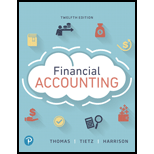
Concept explainers
You are calculating the present value of $1,000 that you will receive five years from now. Which table will you use to obtain the present value factor to multiply to calculate the present value of that $1,000?
- a. Present Value of $1 table
- b. Future Value of $1 table
- c. c Present Value of Ordinary Annuity of $1
- d. Future Value of Ordinary Annuity of $1
To identify: The table that is used to obtain the present value factor to multiply to compute the present value of $1,000 that will be received after five years.
Answer to Problem 1QC
The appropriate answer is Option (a) Present value of $1 table.
Explanation of Solution
Present value: Present value refers to the present worth of the money that is received in future in a lump sum or as series of cash flows at a specified interest rate. When these future sums of money are discounted at a higher rate, the present value of the future cash flows gets lower.
The present value of an investment depends on the following factors:
- The amount of payment or receipt.
- The time gap between the investment and future payment or receipt.
- The interest rate (market interest or stated interest as the case may be).
From the above explanation, it can be concluded that Option (a) Present value of $1 table should be used to compute the present value of $1,000 that will be received after five years,
Hence, Option (a) Present value of $1 table is the correct answer. So, Options (b), (c) and (d) are the incorrect answer.
Therefore, the correct answer is Option (a) Present value of $1 table.
Want to see more full solutions like this?
Chapter F Solutions
Financial Accounting (12th Edition) (What's New in Accounting)
- Can you explain the correct approach to solve this general accounting question?arrow_forwardCan you help me solve this general accounting problem using the correct accounting process?arrow_forwardCan you help me solve this financial accounting question using valid financial accounting techniques?arrow_forward
- The difference between total revenues and total variable costs is known as ______________ Contribution margin Gross margin Operating income Fixed costsarrow_forwardFixed cost per unit decreases when ______________ Production volume increases. Production volume decreases. Variable cost per unit decreases. Variable cost per unit increases.arrow_forwardPlease provide the correct answer to this general accounting problem using valid calculations.arrow_forward
- I need the correct answer to this financial accounting problem using the standard accounting approach.arrow_forwardCost of production report is a ______________ Financial statement Production Process report Order Sheet None of abovearrow_forwardCan you guide me through solving this financial accounting problem using proper techniques?arrow_forward
 Intermediate Accounting: Reporting And AnalysisAccountingISBN:9781337788281Author:James M. Wahlen, Jefferson P. Jones, Donald PagachPublisher:Cengage LearningPrinciples of Accounting Volume 2AccountingISBN:9781947172609Author:OpenStaxPublisher:OpenStax College
Intermediate Accounting: Reporting And AnalysisAccountingISBN:9781337788281Author:James M. Wahlen, Jefferson P. Jones, Donald PagachPublisher:Cengage LearningPrinciples of Accounting Volume 2AccountingISBN:9781947172609Author:OpenStaxPublisher:OpenStax College

